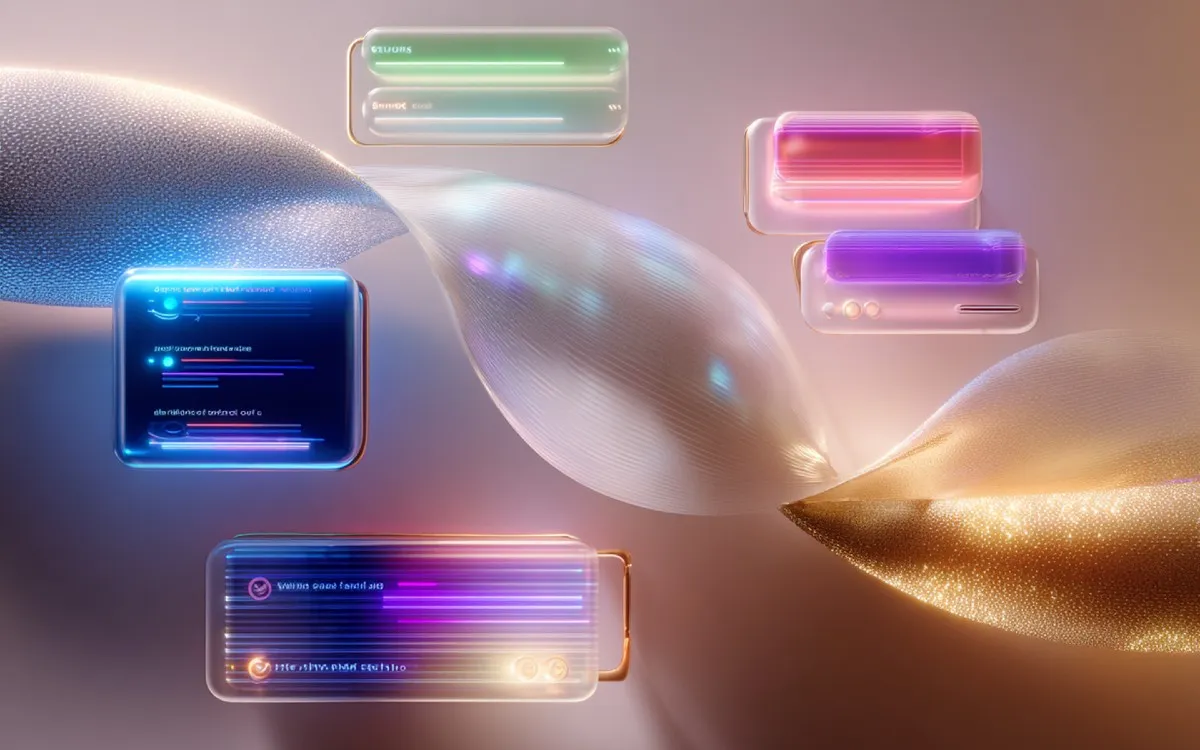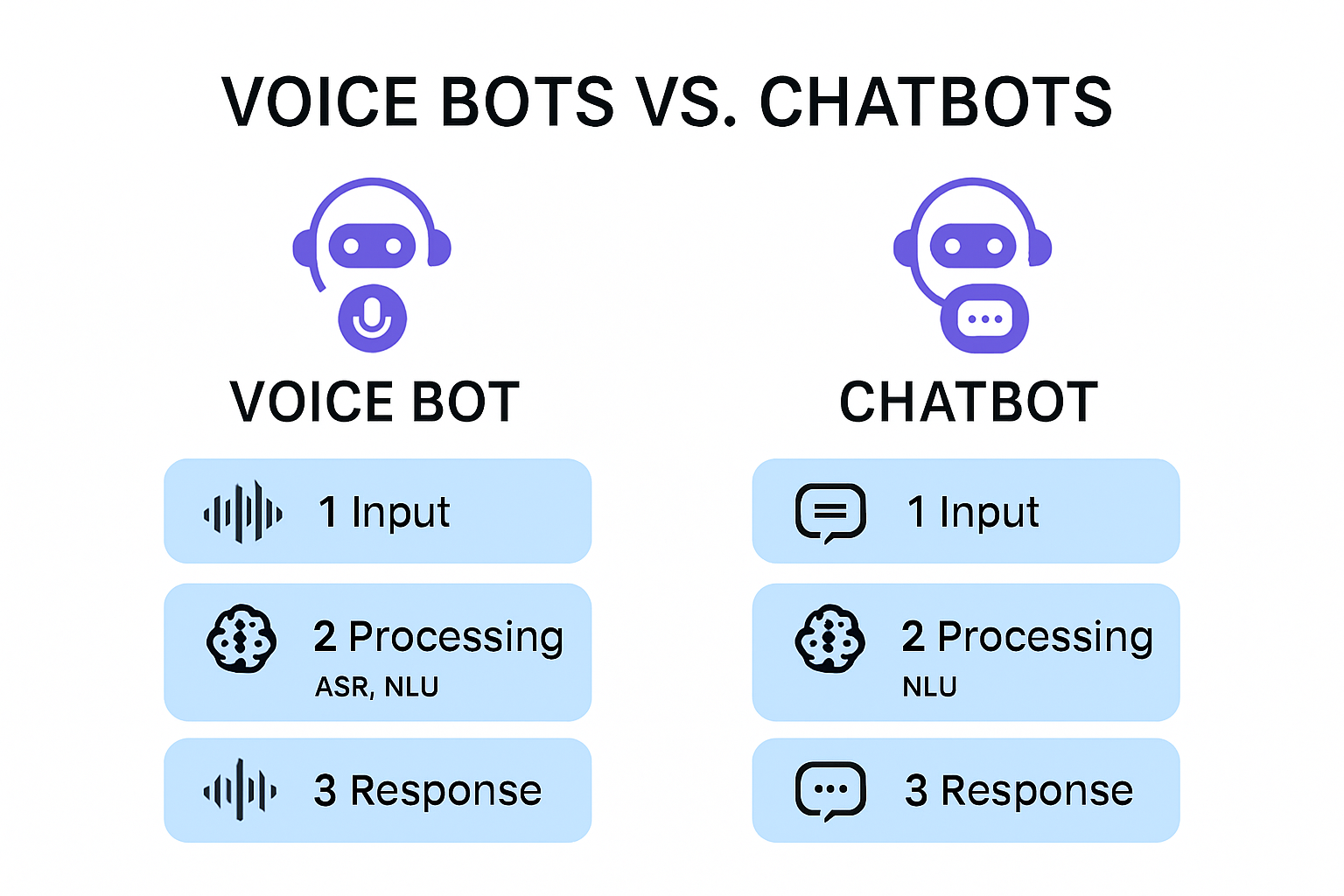Voice Bots vs Chatbots: Key Differences for US Businesses 2025

Understanding voice bots vs chatbots becomes crucial when you consider that by 2025, experts predict that 75% of enterprise conversations will use some kind of AI-powered interface, but voice bots and chatbots are shaping those exchanges in very different ways. It turns out, picking the right one can totally transform your business’s customer experience in ways most people never expect.
Table of Contents
- Understanding Voice Bots And Chatbots
- Key Differences And How They Work
- Benefits For Sales And Marketing Teams
- Choosing The Right Solution For Your Business
Quick Summary
| Takeaway | Explanation |
|---|---|
| Voice Bots and Chatbots Serve Different Needs | Voice bots utilize speech recognition for spoken interactions, while chatbots focus on text-based communication, necessitating a strategic approach based on specific business communication requirements. |
| Technology Impacts Performance and Resources | Voice bots typically require more complex infrastructure and computational resources compared to chatbots, which can be deployed with lower costs and simpler setups. |
| Personalization Enhances Customer Engagement | Voice bots excel in creating intimate, empathetic interactions, while chatbots provide rapid information delivery, both contributing to improved customer engagement and operational efficiency. |
| Hybrid Approaches Can Maximize Benefits | Businesses can leverage both technologies to create a comprehensive communication strategy, enhancing customer interactions by using voice bots for initial engagement and chatbots for detailed follow-up support. |
| Evaluate Long-Term Scalability | When choosing between voice bots and chatbots, consider integration capabilities, capacity to handle various languages, and cost-effectiveness to ensure sustainability and efficiency in customer communication. |
Understanding Voice Bots and Chatbots
Technology continues to transform how businesses communicate with customers, with voice bots and chatbots emerging as powerful digital interaction tools. While these AI-driven solutions might seem similar at first glance, they possess distinct characteristics that can significantly impact customer engagement strategies.
The Core Technological Foundations
Voice bots and chatbots represent two sophisticated approaches to automated communication. A voice bot utilizes advanced speech recognition and natural language processing to interact through spoken conversations, while a chatbot primarily operates through text-based interactions. Research from Gartner suggests that by 2025, approximately 75% of enterprise conversations will involve some form of AI-powered interface.
The fundamental difference lies in their input and output mechanisms. Voice bots process human speech, converting audio signals into text, understanding intent, and generating spoken responses. Chatbots, conversely, work exclusively with written communication, analyzing text inputs and providing corresponding text-based replies. This core technological distinction creates unique user experiences and application scenarios.

Interaction Modalities and User Experience
Customer interaction dynamics differ significantly between voice and text-based interfaces. Voice bots offer a more natural, conversational experience that mimics human dialogue, potentially reducing communication barriers. A Stanford University study revealed that users often perceive voice interactions as more personal and engaging compared to text-based exchanges.
Chatbots excel in scenarios requiring precise information transmission, such as technical support or transactional interactions. They provide users the ability to carefully review and process information at their own pace. Voice bots shine in scenarios demanding real-time, hands-free communication like customer service, navigation assistance, or scheduling appointments.
Businesses considering implementing these technologies must carefully evaluate their specific communication needs. Learn more about custom AI communication solutions to determine the most appropriate approach for their customer engagement strategy.
The choice between voice bots and chatbots isn’t about superiority but strategic alignment. Each technology offers unique advantages that can be leveraged to enhance customer interactions, streamline support processes, and create more intelligent, responsive communication channels.
To help clarify the unique characteristics and scenarios ideal for each technology, the table below compares key features of Voice Bots and Chatbots as discussed in the article:
| Feature / Scenario | Voice Bots | Chatbots |
|---|---|---|
| Input & Output | Spoken conversation using speech recognition | Text-based communication |
| User Experience | Natural, personal, empathetic interactions | Rapid, precise, process-at-own-pace |
| Best Use Cases | Real-time, hands-free (e.g., appointments, navigation) | Technical/transactional support, FAQs |
| Core Technology | Speech-to-text, NLP, speech synthesis | Text analysis, pattern matching, chatbot frameworks |
| Infrastructure Requirements | More robust computing, specialized hardware | Less resource intensive, easier setup |
| Personalization Strength | Adapting tone, processing emotion/tone | Automated yet scalable information delivery |
| Scalability | More complex, but improving | High, easily scales across channels |
Key Differences and How They Work
The technological architecture and functional mechanisms of voice bots and chatbots reveal critical distinctions that impact their performance, usability, and integration potential for businesses. Understanding these nuanced differences helps organizations make informed decisions about digital communication strategies.
Technological Processing and Input Mechanisms
Voice bots and chatbots fundamentally differ in how they process and interpret user input. Research from MIT Technology Review demonstrates that voice bots require more complex processing layers compared to traditional chatbots. Voice bot systems must first convert audio signals into text through advanced speech recognition algorithms, then analyze linguistic nuances, intent, and context. This multi-stage process involves:
- Acoustic Processing: Converting sound waves into digital signals
- Phonetic Matching: Identifying individual word components
- Natural Language Understanding: Interpreting semantic meaning
Chatbots, by contrast, work directly with text inputs, eliminating the initial audio-to-text conversion stage. This allows for more straightforward pattern matching and faster response generation.

Response Generation and Contextual Understanding
The response generation mechanisms further distinguish these technologies. A study by Stanford University’s Human-Computer Interaction Lab revealed that voice bots must consider additional contextual elements like tone, speech cadence, and acoustic characteristics when generating responses. This requires more sophisticated natural language generation models capable of producing human-like spoken interactions.
Chatbots typically generate responses through:
- Rule-based matching
- Machine learning algorithms
- Predefined conversation scripts
Voice bots incorporate additional layers such as:
- Speech synthesis technologies
- Emotional tone modeling
- Pronunciation and accent normalization
Integration and Technical Infrastructure
Businesses seeking to implement these technologies must carefully evaluate their technical infrastructure and communication requirements. Explore advanced AI communication solutions that can seamlessly integrate with existing systems.
Voice bots generally demand more robust computational resources due to their complex audio processing requirements. They need specialized hardware and software capable of handling real-time speech recognition, natural language processing, and voice synthesis. Chatbots, being text-based, can operate with relatively less computational overhead.
The choice between voice bots and chatbots depends on specific business needs, target audience preferences, and technological capabilities. While both technologies aim to enhance customer interaction, their underlying mechanisms and implementation strategies differ significantly.
Technological evolution continues to blur these distinctions, with emerging AI models creating increasingly sophisticated and adaptable communication interfaces that can potentially combine voice and text interaction capabilities.
Benefits for Sales and Marketing Teams
Sales and marketing teams stand at the forefront of technological transformation, with voice bots and chatbots offering unprecedented opportunities to enhance customer engagement and operational efficiency. These AI-powered communication tools are redefining how businesses interact with potential and existing customers.
Lead Generation and Qualification Strategies
Research from Salesforce indicates that AI-driven communication tools can increase lead conversion rates by up to 40%. Voice bots and chatbots provide unique advantages in the lead generation process. Voice bots excel in creating more personal, conversational interactions that can build immediate rapport with potential customers. They capture nuanced communication cues through vocal tone and speech patterns, offering a more empathetic approach to initial customer interactions.
Chatbots, meanwhile, offer precision and scalability in lead qualification. They can simultaneously handle multiple interactions, quickly filtering and categorizing potential leads based on predefined criteria. This allows sales teams to focus their energy on high-potential prospects, dramatically improving overall efficiency.
Customer Engagement and Personalization
Personalization has become the cornerstone of modern marketing strategies. A Harvard Business Review study revealed that personalized communication can increase customer engagement by 55%. Voice bots provide a more intimate communication channel, capable of adapting their tone and language to match individual customer preferences. Their ability to process emotional nuances makes them particularly effective in building customer relationships.
Chatbots shine in scenarios requiring rapid, accurate information delivery. They can instantly provide product details, answer frequently asked questions, and guide customers through complex decision-making processes. Their text-based nature allows for easy integration with existing CRM systems, enabling seamless data tracking and analysis.
Operational Efficiency and Cost Reduction
Implementing AI communication tools represents a strategic approach to optimizing business operations. Learn more about intelligent lead qualification strategies to understand how these technologies can transform your customer interaction processes.
The cost-effectiveness of voice bots and chatbots cannot be overstated. By automating initial customer interactions, businesses can significantly reduce customer service overhead. Voice bots can handle complex queries that traditionally required human intervention, while chatbots provide 24/7 support without additional staffing costs.
Businesses must carefully evaluate their specific needs when choosing between voice bots and chatbots. The ideal solution often involves a strategic combination of both technologies, creating a comprehensive communication ecosystem that maximizes customer engagement and operational efficiency.
As AI technologies continue to evolve, sales and marketing teams that embrace these innovative communication tools will gain a significant competitive advantage in an increasingly digital business landscape.
The following table summarizes key benefits of Voice Bots and Chatbots for sales and marketing teams, focusing on lead generation, engagement, and operational efficiency:
| Benefit Area | Voice Bots | Chatbots |
|---|---|---|
| Lead Generation | Personal, empathetic conversations; builds rapport | Rapid lead qualification; scalable simultaneous interactions |
| Customer Engagement | Adapts tone & language; builds closer relationships | Prompt, accurate info delivery; CRM integration |
| Personalization | Processes emotional nuance; higher intimacy | Automated tailored responses; data-driven |
| Operational Efficiency | Handles complex queries, reduces live agent load | 24/7 multi-chat support; reduces staffing costs |
| Integration & Analysis | Integrates with voice systems (IVR, phone, etc.) | Easily links with CRM & sales platforms |
Choosing the Right Solution for Your Business
Selecting the appropriate communication technology is a critical strategic decision that can significantly impact a business’s customer engagement and operational efficiency. Voice bots and chatbots each offer unique advantages, and the optimal choice depends on multiple factors specific to an organization’s needs and goals.
Assessing Business Communication Requirements
Research from Gartner suggests that businesses should conduct a comprehensive analysis of their communication needs before implementing AI-driven solutions. This involves evaluating several key dimensions:
- Customer Demographics: Understanding the age, technological comfort, and communication preferences of your target audience
- Industry Specific Interactions: Analyzing the typical complexity and nature of customer communications in your sector
- Existing Technology Infrastructure: Evaluating current systems and their compatibility with voice or text-based AI solutions
Companies in technical support, healthcare, and financial services might lean towards voice bots for their ability to handle nuanced, complex interactions. Conversely, businesses with straightforward transactional needs may find chatbots more efficient and cost-effective.
Technical and Financial Considerations
A McKinsey & Company study revealed that successful AI implementation requires careful consideration of both technological capabilities and financial implications. Voice bots typically demand more sophisticated infrastructure, including advanced speech recognition systems, natural language processing capabilities, and robust computational resources.
Chatbots offer a more accessible entry point for businesses beginning their AI communication journey. They require less complex technical setup, lower initial investment, and can be more quickly deployed across multiple communication channels. This makes them an attractive option for small to medium-sized businesses looking to enhance their customer interaction capabilities.
Implementation and Scalability Strategy
Businesses must think beyond immediate needs and consider long-term scalability. Explore strategies for intelligent AI communication solutions to understand how these technologies can evolve with your business.
The most effective approach often involves a hybrid strategy that combines voice and text-based communication tools. This allows businesses to leverage the strengths of both technologies, creating a more comprehensive and flexible customer engagement ecosystem. For instance, a voice bot might handle initial customer interactions, with a chatbot providing follow-up support and detailed information.
Key factors to consider include:
- Integration capabilities with existing CRM systems
- Ability to handle multiple languages and accents
- Scalability and ease of updating communication protocols
- Cost of implementation and ongoing maintenance
Ultimately, the decision between voice bots and chatbots is not about choosing a superior technology, but finding the most appropriate solution for your specific business context. Businesses should approach this decision as a strategic investment in customer communication, carefully weighing technological capabilities, financial considerations, and long-term organizational goals.
Unlock the True Value of Voice AI for Your Business
Are you struggling to choose between voice bots and chatbots as you modernize customer engagement? This article highlights how US businesses face critical decisions around personalization, real-time service, and scalable communication. The difference in customer experience can feel overwhelming, especially when your team needs both empathy and efficiency without extra operational costs.
Imagine AI agents that do not force you to compromise. At NextLevel AI, we design fully adaptable Voice AI agents that bridge the gap. Our solutions empower you to:
- Deliver human-like interactions suited for both voice and text
- Seamlessly integrate across every channel your customers use
- Boost lead qualification speed and build stronger customer relationships
Do not let your competitors outpace you in 2025 with outdated tech. Visit NextLevel AI to see how you can transform sales, support or marketing with intelligent omnichannel agents. Want to dig deeper? Explore specific AI-powered voice and chatbot solutions to match your exact business needs today.
Recommended
- AI Chatbot for Website That Talks to Visitors – NextLevel
- NextLevel – Voice AI Agents Tailored for Your Business
- Custom AI Voice Chatbot – Make Your Mobile App Smarter
- AI BDR Agent: Lead Qualification & Engagement – NextLevel.AI
- The Ultimate Guide to Small Business Automation: A 2025 Playbook for The Chief Everything Officer | 12AM Agency
- Top Digital Trends for Small Businesses in 2025 | Ibrandmedia
Frequently Asked Questions
What is the main difference between voice bots and chatbots?
Voice bots use speech recognition to facilitate spoken conversations, while chatbots operate through text-based communication. This distinction affects how businesses engage with customers.
How do voice bots enhance customer engagement compared to chatbots?
Voice bots create more personal, empathetic interactions by mimicking human dialogue, while chatbots provide rapid information delivery, making both effective in their own contexts.
What are the cost implications of implementing voice bots versus chatbots?
Voice bots typically require more complex infrastructure and higher initial investment, while chatbots can be deployed with lower costs and simpler setups, making them more accessible for smaller businesses.
Can businesses use both voice bots and chatbots?
Yes, many businesses adopt a hybrid approach, utilizing voice bots for initial customer interactions and chatbots for detailed follow-up support, maximizing the benefits of both technologies.



